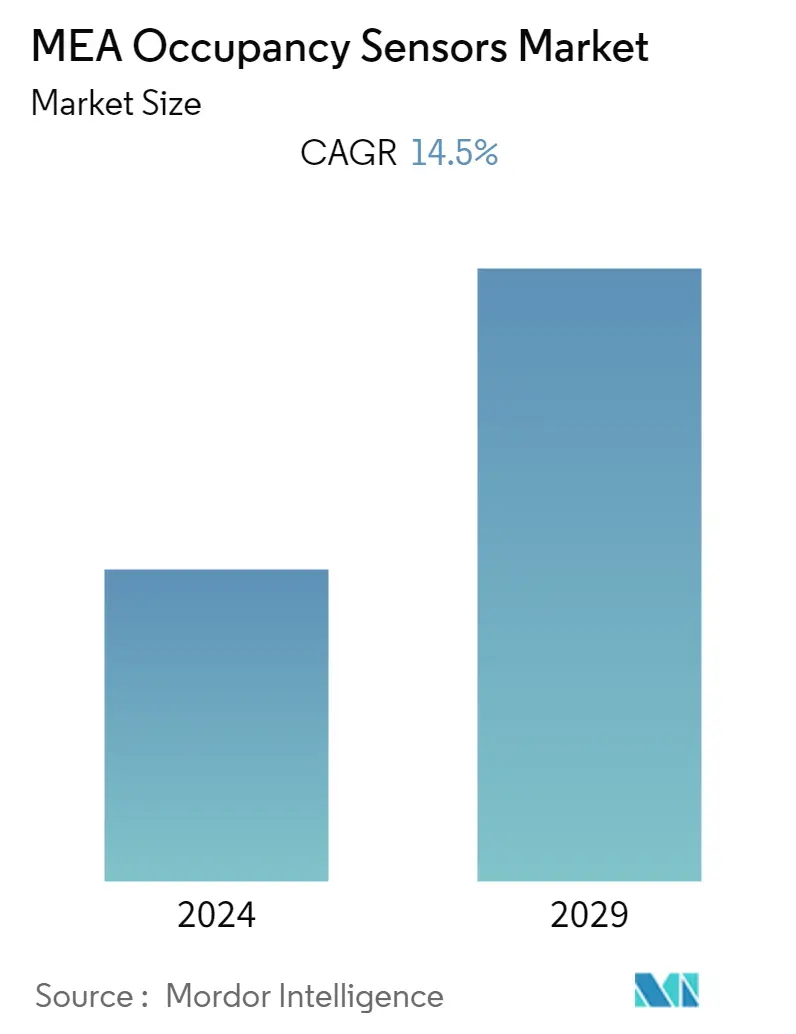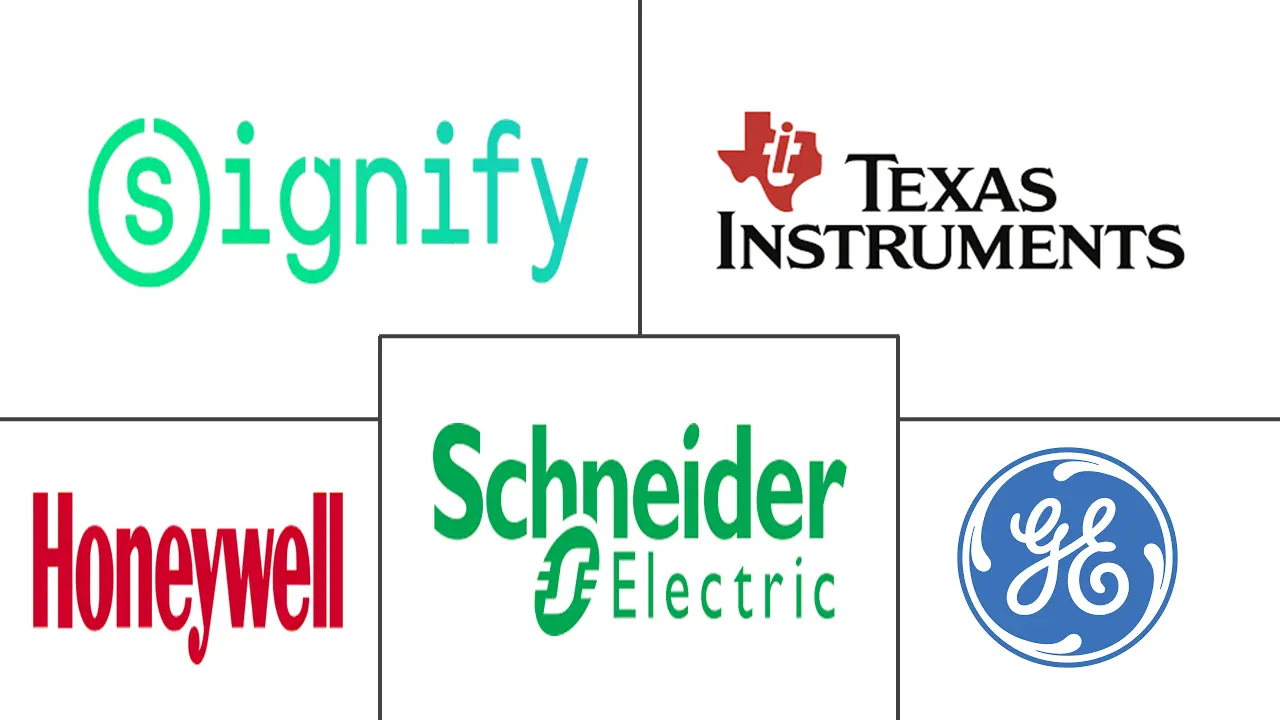Market Size of MEA Occupancy Sensors Industry

| Study Period | 2019 - 2029 |
| Base Year For Estimation | 2023 |
| Forecast Data Period | 2024 - 2029 |
| Historical Data Period | 2019 - 2022 |
| CAGR | 14.50 % |
| Market Concentration | Medium |
Major Players
*Disclaimer: Major Players sorted in no particular order |
MEA Occupancy Sensors Market Analysis
The Middle East and Africa Occupancy Sensors Market is expected to register a CAGR of 14.5% during the forecast period, 2021-2026. Smart building technology and occupancy sensors can provide real-time data, allowing to make better decisions for building management under the new guidelines of COVID-19. Whether saving space or improving hygiene, occupancy IoT sensors can help mobilize and optimize the back-to-work process in the region.
- Occupancy sensors indicate the presence or absence of occupants in a space using various technologies such as passive infrared, ultrasonic, and dual-technology. Passive-infrared sensors necessitate a line of sight between the sensor and the space's occupants.
- Further, to reduce energy waste, most energy codes require some method of automatically turning off lights when they are not in use, either on a schedule or based on occupancy. Occupancy sensors are lighting controls that turn off lights in unoccupied areas, lowering energy costs by reducing energy waste. Also, various vendors in the region are introducing Ultrasonic sensors to detect the presence of people by emitting ultrasonic sound waves into the environment and measuring the speed with which they return.
- Also, there is an increasing focus on Dual-technology sensors that use both passive infrared and ultrasonic technologies to detect the presence of occupants and activate the lights only when both technologies detect the presence of occupants. This configuration virtually eliminates the possibility of false-on problems, and requiring either technology to keep the lights on significantly reduces the possibility of false-off problems.
- Occupancy sensors have primarily been used to detect motion rather than the presence or other more essential occupancy features, including count, location, track, and identity. Also, New technology is expanding rapidly to detect higher-value features of occupancy.
MEA Occupancy Sensors Industry Segmentation
An occupancy sensor is used to save energy, comply with building codes, and provide automatic control and various other such applications. One of the most-used technologies among the occupancy sensors is the passive infrared, which detects occupancy within a specific field and activates lighting, and is extremely useful in small spaces. Moreover, the advent of advanced occupancy sensors, such as micro-phonics, intelligent occupancy sensors, image processing occupancy sensors, and the new vision-based intelligent occupancy sensor, for HVAC systems is fueling the growth of the occupancy sensor market.
| By Network Type | |
| Wired | |
| Wireless |
| By Technology | |
| Ultrasonic | |
| Passive Infrared | |
| Microwave |
| By Application | |
| Lighting Control | |
| HVAC | |
| Security and Surveillance |
| By Building Type | |
| Residential | |
| Commercial |
| By Country | |
| Saudi Arabia | |
| United Arab Emirates | |
| South Africa | |
| Rest of Middle East and Africa |
MEA Occupancy Sensors Market Size Summary
The Middle East and Africa Occupancy Sensors Market is experiencing significant growth, driven by the increasing adoption of smart building technologies and the need for efficient space management solutions. Occupancy sensors, which utilize technologies such as passive infrared, ultrasonic, and dual-technology, are becoming essential in optimizing building management and reducing energy consumption. These sensors play a crucial role in automating lighting controls, thereby minimizing energy waste and lowering operational costs. The market is also witnessing a shift towards advanced sensor technologies that offer enhanced features like motion detection, occupancy counting, and location tracking, further supporting the demand for energy-efficient devices across various sectors.
The competitive landscape of the Middle East and Africa Occupancy Sensors Market is characterized by strategic initiatives such as product launches, partnerships, and acquisitions by key players. Companies are focusing on innovation and research to develop sophisticated sensor solutions that cater to diverse applications, including security, access control, and energy management. The market's growth is further bolstered by the rising demand for energy-efficient and smart lighting control systems, which are increasingly being integrated into commercial and residential spaces. Additionally, the positive economic outlook in the region, supported by initiatives like the African Continental Free Commerce Agreement, is expected to create new opportunities for market expansion.
MEA Occupancy Sensors Market Size - Table of Contents
-
1. MARKET INSIGHTS
-
1.1 Market Overview
-
1.2 Industry Attractiveness - Porter's Five Forces Analysis
-
1.2.1 Bargaining Power of Suppliers
-
1.2.2 Bargaining Power of Consumers
-
1.2.3 Threat of New Entrants
-
1.2.4 Threat of Substitutes
-
1.2.5 Intensity of Competitive Rivalry
-
-
1.3 Impact of COVID-19 on the Market
-
-
2. MARKET SEGMENTATION
-
2.1 By Network Type
-
2.1.1 Wired
-
2.1.2 Wireless
-
-
2.2 By Technology
-
2.2.1 Ultrasonic
-
2.2.2 Passive Infrared
-
2.2.3 Microwave
-
-
2.3 By Application
-
2.3.1 Lighting Control
-
2.3.2 HVAC
-
2.3.3 Security and Surveillance
-
-
2.4 By Building Type
-
2.4.1 Residential
-
2.4.2 Commercial
-
-
2.5 By Country
-
2.5.1 Saudi Arabia
-
2.5.2 United Arab Emirates
-
2.5.3 South Africa
-
2.5.4 Rest of Middle East and Africa
-
-
MEA Occupancy Sensors Market Size FAQs
What is the current MEA Occupancy Sensors Market size?
The MEA Occupancy Sensors Market is projected to register a CAGR of 14.5% during the forecast period (2024-2029)
Who are the key players in MEA Occupancy Sensors Market?
Signify Holding BV, Texas Instruments Inc, Schneider Electric SE, Honeywell Inc and General Electric Co are the major companies operating in the MEA Occupancy Sensors Market.

